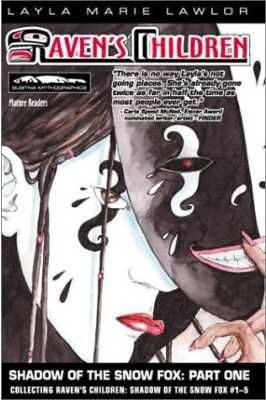

Raven's Children Vol. 1: Shadow of the Snow Fox, Part One
There's no easy way to describe Layla Marie Lawlor's Raven's Children in just a few sentences. Multiple storylines weave together into a complicated tale of love and hate, friendship and betrayal, magic and redemption, culture clash and interpersonal conflict. In a windswept Arctic wasteland, a small Stone Age tribe, the Raven's Children, have become pawns in a war that has nothing to do with them—a territory conflict between invaders from the south and local herdsfolk who are ancestral enemies of the Raven's Children. Against a backdrop of political machinations and conflict on a national scale, the characters struggle with their own personal demons (literally, in some cases).
The Arctic setting is a familiar one for Lawlor, who grew up in Alaska and has drawn heavily on the landscape of her childhood in the creation of the world of Raven's Children. The detailed backgrounds of frozen swamps, spruce trees and blizzard-scoured cliffsides are drawn from reference photos that she took of the area around her parents' cabin, and the culture, mythology and history of the Raven's Children is loosely based upon Alaskan native tribes.
Like trying to navigate another person's dreamtime, Raven's Children is both entrancing and strange. It has the kind of straightforward complexity that one only finds in the tales of human origin, as well as that same kind of wry, knowing humor.
Though the pages are peopled with foreign characters in foreign circumstances, what resonates is how familiar they are. We know these people. Their triumphs and their troubles are universal. We are these people. Even their deities and spirits are familiar. We all know them, we meet them every day. And that's what makes this book so appealing. Despite the fantastic setting, all the characters (mortals and spirits alike) are within our grasp.
Ms. Lawlor makes it easy for us by allowing her creations to speak as we speak. She doesn't litter their speech with pseudo-Shakespearean affectations. She understands that her audience is smart enough to understand that the world of RC is far removed from our own, without any of the typical fantasy shorthand. And as such, we are treated to some delightful dialogue without a single 'thee' or 'thou', and nary a 'zounds' in sight.

Rob's review
RAVEN'S CHILDREN is kind of a cross between manga, fantasy, and Native American storytelling. Though the story supposedly takes place on another world, the tribes are similar to those in Alaska and the Pacific Northwest. Characters have names such as Deneko the Snow Fox and Coyote Woman, which leads one to wonder how an alien planet could have snow foxes and coyotes (along with dogs and ravens). There's even an occasional use of Pacific Northwest iconography, which leads one to think that perhaps these people are descended from transplanted Native Americans.
On the plus side, I agree with the comments above. The characters are rich, deep, and realistic—much more so than in your typical Lord of the Rings-style fantasy. So are the different groups of peoples—their customs, languages, and beliefs. Lawlor seems to love anthropology and it shows. Her fictional cultures are more detailed and believable than any that I can recall seeing.
On the minus side, her artwork is crude with only occasional scenes of grace and beauty. Sometimes it's impossible to tell the characters apart. Which is a big problem because of the other big problem: too many characters.
This series isn't just complex or complicated, it's confusing. The front and back inside covers provide an illustrated guide to 23 characters. Inside the book is a "Who's Who in Raven's Children" that lists 30 characters and a "Raven's Children Family Tree" that charts the relationships between 50-plus characters.
If you have to provide three different types of guides to your characters, it's a sign that something's wrong. Because Lawlor gives so many characters time, only a few of them stand out. She would've served the work better by focusing on a few characters and minimizing or eliminating the others.
Because of these flaws, I can't recommend RAVEN'S CHILDREN wholeheartedly. Fans of Tolkein-like fantasies with multilayered cultures and genealogies may find it captivating. Others may find it almost impenetrable. Let's say it's fascinating but frustrating.
For more information or to buy the comics, go to Raven's Children.
Related links
Comic books featuring Indians
|
. . . |

|
All material © copyright its original owners, except where noted.
Original text and pictures © copyright 2007 by Robert Schmidt.
Copyrighted material is posted under the Fair Use provision of the Copyright Act,
which allows copying for nonprofit educational uses including criticism and commentary.
Comments sent to the publisher become the property of Blue Corn Comics
and may be used in other postings without permission.